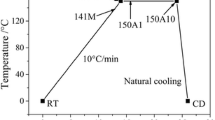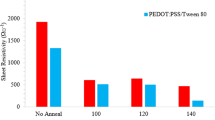Abstract
Four kinds of polypropylene (PP) cast films with different die draw ratios (DDR) were prepared. The impact of different DDR on the crystalline and oriented properties of PP cast films and annealed films was explored herein. Wide angle X-ray diffraction (WAXD) and fourier transform infrared (FTIR) methods were adopted to examine the orientation degree of crystalline and amorphous phases. Long period distance (Lp) of the crystalline structure was tested by small angle X-ray scattering (SAXS). Crystallization was determined by differential scanning calorimeter (DSC). The oriented and crystalline behaviors of the samples were carried out by the elastic recovery (ER) testing. Then, samples after being annealed were examined by the same methods. The influence of annealing process on the films’ structures and properties was explored. Besides, the final stretched microporous membranes manufactured via stretching the annealed films along machine direction were examined by scanning electronic microscope (SEM). No matter for cast films or for annealed films, it is found that the films’ orientation degree of crystalline and amorphous phases, as well as Lp and crystallinity are larger at higher DDR and relatively lower at lower DDR. When the DDR is overly high (DDR = 170), both the oriented and crystalline properties will decline. Elastic recovery testing indicates that a film with better orientation of the crystalline and the amorphous phases as well as with higher crystallinity can be obtained at an appropriate DDR. SEM images show that stretched membranes with better microporous structure can be obtained when the precursor film is prepared at a proper DDR.








Similar content being viewed by others
References
Zhang SS (2007) A review on the separators of liquid electrolyte Li-ion batteries. J Power Sources 164(1):351–364
Tabatabaei SH, Carreau PJ, Ajji A (2008) Microporous membranes obtained from polypropylene blend films by stretching. J Membr Sci 325(2):772–782
Sadeghi F, Ajji A, Carreau PJ (2007) Analysis of microporous membranes obtained from polypropylene films by stretching. J Membr Sci 292(1):62–71
Tabatabaei SH, Carreau PJ, Ajji A (2009) Microporous membranes obtained from PP/HDPE multilayer films by stretching. J Membr Sci 345(1):148–159
Johnson MB (2000) Investigations of the processing-structure-property relationships of selected semicrystalline. Polymers
Kang J, Xiong B, Liu D, Cao Y, Chen J, Yang F, Xiang M (2014) Understanding in the morphology and tensile behavior of isotactic polypropylene cast films with different stereo-defect distribution. J Polym Res 21(6):485
Wang Y, Na B, Fu Q, Men Y (2004) Shear induced shish–kebab structure in PP and its blends with LLDPE. Polymer 45(1):207–215
Wu T, Xiang M, Cao Y, Yang F (2014) Influence of annealing on stress–strain behaviors and performances of β nucleated polypropylene stretched membranes. J Polym Res 21(11):1–13
Changbin C, Caihong L, Qi C, Haibin M, Ruijie X (2015) Influence of annealing time on the structure and properties of high-density polyethylene microporous membrane. J Plast Film Sheeting 31(1):78–95
Sadeghi F, Tabatabaei S, Ajji A, Carreau P (2010) Properties of uniaxially stretched polypropylene films: effect of drawing temperature and random copolymer content. Can J Chem Eng 88(6):1091–1098
Zuo F, Keum JK, Chen X, Hsiao BS, Chen H, Lai S-Y, Wevers R, Li J (2007) The role of interlamellar chain entanglement in deformation-induced structure changes during uniaxial stretching of isotactic polypropylene. Polymer 48(23):6867–6880
Sadeghi F, Ajji A, Carreau PJ (2007) Analysis of row nucleated lamellar morphology of polypropylene obtained from the cast film process: effect of melt rheology and process conditions. Polym Eng Sci 47(7):1170–1178
Sadeghi F, Ajji A, Carreau P (2005) Study of polypropylene morphology obtained from blown and cast film processes: initial morphology requirements for making porous membrane by stretching. J Plast Film Sheeting 21(3):199–216
Hu B, Lei C, Xu R, Shi W, Cai Q, Mo H, Chen C (2014) Influence of melt-draw ratio on the structure and properties of poly (vinylidiene fluoride) cast film. J Plastic Film Sheeting 30(3):300–313
Tabatabaei SH, Carreau PJ, Ajji A (2009) Structure and properties of MDO stretched polypropylene. Polymer 50(16):3981–3989
Xu R, Chen X, Xie J, Cai Q, Lei C (2015) Influence of melt-draw ratio on the crystalline structure and properties of polypropylene cast film and stretched microporous membrane. Ind Eng Chem Res 54(11):2991–2999
Tatulian SA, Jones LR, Reddy LG, Stokes DL, Tamm LK (1995) Secondary structure and orientation of phospholamban reconstituted in supported bilayers from polarized attenuated total reflection FTIR spectroscopy. Biochemistry 34(13):4448–4456
Luongo J (1960) Infrared study of polypropylene. J Appl Polym Sci 3(9):302–309
Tabatabaei SH, Carreau PJ, Ajji A (2009) Effect of processing on the crystalline orientation, morphology, and mechanical properties of polypropylene cast films and microporous membrane formation. Polymer 50(17):4228–4240
Xu H, Cebe P (2004) Heat capacity study of isotactic polystyrene: dual reversible crystal melting and relaxation of rigid amorphous fraction. Macromolecules 37(8):2797–2806
Wang X, Zhou J, Li L (2007) Multiple melting behavior of poly (butylene succinate). Eur Polym J 43(8):3163–3170
Park I, Noether H (1975) Crystalline “hard” elastic materials. Colloid Polym Science 253(10):824–839
Pawlak A, Galeski A, Rozanski A (2014) Cavitation during deformation of semicrystalline polymers. Prog Polym Sci 39(5):921–958
Acknowledgements
We gratefully acknowledge the National Science Foundation of China (NSFC 51503134, 51421061, 51721091) and the State Key Laboratory of Polymer Materials Engineering (Grant No. SKLPME 2017-3-02) for the financial support.
Author information
Authors and Affiliations
Corresponding author
Rights and permissions
About this article
Cite this article
Xu, R., Zeng, S., Wang, J. et al. Impact of different die draw ratio on crystalline and oriented properties of polypropylene cast films and annealed films. J Polym Res 25, 142 (2018). https://doi.org/10.1007/s10965-018-1534-2
Received:
Accepted:
Published:
DOI: https://doi.org/10.1007/s10965-018-1534-2




